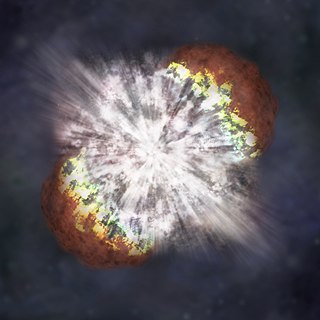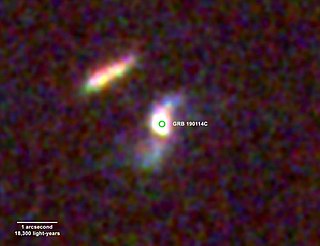
In gamma-ray astronomy, gamma-ray bursts (GRBs) are immensely energetic events occurring in distant galaxies which represent the brightest and "most powerful class of explosion in the universe." These extreme electromagnetic events are second only to the Big Bang as the most energetic and luminous phenomenon ever known. Gamma-ray bursts can last from a few milliseconds to several hours. After the initial flash of gamma rays, a longer-lived § afterglow is emitted, usually in the longer wavelengths of X-ray, ultraviolet, optical, infrared, microwave or radio frequencies.
An active galactic nucleus (AGN) is a compact region at the center of a galaxy that emits a significant amount of energy across the electromagnetic spectrum, with characteristics indicating that this luminosity is not produced by the stars. Such excess, non-stellar emissions have been observed in the radio, microwave, infrared, optical, ultra-violet, X-ray and gamma ray wavebands. A galaxy hosting an AGN is called an active galaxy. The non-stellar radiation from an AGN is theorized to result from the accretion of matter by a supermassive black hole at the center of its host galaxy.

A super-luminous supernova is a type of stellar explosion with a luminosity 10 or more times higher than that of standard supernovae. Like supernovae, SLSNe seem to be produced by several mechanisms, which is readily revealed by their light-curves and spectra. There are multiple models for what conditions may produce an SLSN, including core collapse in particularly massive stars, millisecond magnetars, interaction with circumstellar material, or pair-instability supernovae.

Messier 87 is a supergiant elliptical galaxy in the constellation Virgo that contains several trillion stars. One of the largest and most massive galaxies in the local universe, it has a large population of globular clusters—about 15,000 compared with the 150–200 orbiting the Milky Way—and a jet of energetic plasma that originates at the core and extends at least 1,500 parsecs, traveling at a relativistic speed. It is one of the brightest radio sources in the sky and a popular target for both amateur and professional astronomers.

An astrophysical jet is an astronomical phenomenon where outflows of ionised matter are emitted as extended beams along the axis of rotation. When this greatly accelerated matter in the beam approaches the speed of light, astrophysical jets become relativistic jets as they show effects from special relativity.
Cygnus X-3 is a high-mass X-ray binary (HMXB), one of the stronger binary X-ray sources in the sky. It is often considered to be a microquasar, and it is believed to be a compact object in a binary system which is pulling in a stream of gas from an ordinary star companion. It is one of only two known HMXBs containing a Wolf–Rayet star. It is invisible visually, but can be observed at radio, infrared, X-ray, and gamma-ray wavelengths.
Gamma-ray burst emission mechanisms are theories that explain how the energy from a gamma-ray burst progenitor is turned into radiation. These mechanisms are a major topic of research as of 2007. Neither the light curves nor the early-time spectra of GRBs show resemblance to the radiation emitted by any familiar physical process.

Gamma-ray burst progenitors are the types of celestial objects that can emit gamma-ray bursts (GRBs). GRBs show an extraordinary degree of diversity. They can last anywhere from a fraction of a second to many minutes. Bursts could have a single profile or oscillate wildly up and down in intensity, and their spectra are highly variable unlike other objects in space. The near complete lack of observational constraint led to a profusion of theories, including evaporating black holes, magnetic flares on white dwarfs, accretion of matter onto neutron stars, antimatter accretion, supernovae, hypernovae, and rapid extraction of rotational energy from supermassive black holes, among others.

GRB 101225A, also known as the "Christmas burst", was a cosmic explosion first detected by NASA's Swift observatory on Christmas Day 2010. The gamma-ray emission lasted at least 28 minutes, which is unusually long. Follow-up observations of the burst's afterglow by the Hubble Space Telescope and ground-based observatories were unable to determine the object's distance using spectroscopic methods.
Multi-messenger astronomy is the coordinated observation and interpretation of multiple signals received from the same astronomical event. Many types of cosmological events involve complex interactions between a variety of astrophysical processes, each of which may independently emit signals of a characteristic "messenger" type: electromagnetic radiation, gravitational waves, neutrinos, and cosmic rays. When received on Earth, identifying that disparate observations were generated by the same source can allow for improved reconstruction or a better understanding of the event, and reveals more information about the source.

A tidal disruption event (TDE) is a transient astronomical source produced when a star passes so close to a supermassive black hole (SMBH) that it is pulled apart by the black hole's tidal force. The star undergoes spaghettification, producing a tidal stream of material that loops around the black hole. Some portion of the stellar material is captured into orbit, forming an accretion disk around the black hole, which emits electromagnetic radiation. In a small fraction of TDEs, a relativistic jet is also produced. As the material in the disk is gradually consumed by the black hole, the TDE fades over several months or years.

NGC 4993 is a lenticular galaxy located about 140 million light-years away in the constellation Hydra. It was discovered on 26 March 1789 by William Herschel and is a member of the NGC 4993 Group.

GRB 190114C was an extreme gamma-ray burst explosion from a galaxy 4.5 billion light years away (z=0.4245; magnitude=15.60est) near the Fornax constellation, that was initially detected in January 2019. The afterglow light emitted soon after the burst was found to be tera-electron volt radiation from inverse Compton emission, identified for the first time. According to the astronomers, "We observed a huge range of frequencies in the electromagnetic radiation afterglow of GRB 190114C. It is the most extensive to date for a gamma-ray burst." Also, according to other astronomers, "light detected from the object had the highest energy ever observed for a GRB: 1 Tera electron volt (TeV)—about one trillion times as much energy per photon as visible light"; another source stated, "the brightest light ever seen from Earth [to date]."

In astronomy, a fast blue optical transient (FBOT), or more specifically, luminous fast blue optical transient (LFBOT), is an explosive transient event similar to supernovae and gamma-ray bursts with high optical luminosity, rapid evolution, and predominantly blue emission. The origins of such explosions are currently unclear, with events occurring at not more than 0.1% of the typical core-collapse supernova rate. This class of transients initially emerged from large sky surveys at cosmological distances, yet in recent years a small number have been discovered in the local Universe, most notably AT 2018cow.

III Zw 2 is a Seyfert 1 galaxy located in the Pisces constellation. It has a redshift of 0.089 and is notable as the first of its kind to exhibit a superluminal jet.

GRB 221009A was an extraordinarily bright and very energetic gamma-ray burst (GRB) jointly discovered by the Neil Gehrels Swift Observatory and the Fermi Gamma-ray Space Telescope on October 9, 2022. The gamma-ray burst was ten minutes long, but was detectable for more than ten hours following initial detection. Despite being around 2.4 billion light-years away, it was powerful enough to affect Earth's atmosphere, having the strongest effect ever recorded by a gamma-ray burst on the planet. The peak luminosity of GRB 221009A was measured by Konus-Wind to be ~ 2.1 × 1047 W and by Fermi Gamma-ray Burst Monitor to be ~ 1.0 × 1047 W over its 1.024s interval. A burst as energetic and as close to Earth as 221009A is thought to be a once-in-10,000-year event. It was the brightest and most energetic gamma-ray burst ever recorded, with some dubbing it the BOAT, or Brightest Of All Time.

AT 2021lwx (also known as ZTF20abrbeie or "Scary Barbie") is the most energetic non-quasar optical transient astronomical event ever observed, with a peak luminosity of 7 × 1045 erg per second (erg s−1) and a total radiated energy between 9.7 × 1052 erg to 1.5 × 1053 erg over three years. Despite being lauded as the largest explosion ever, GRB 221009A was both more energetic and brighter. It was first identified in imagery obtained on 13 April 2021 by the Zwicky Transient Facility (ZTF) astronomical survey and is believed to be due to the accretion of matter into a super massive black hole (SMBH) heavier than one hundred million solar masses (M☉). It has a redshift of z = 0.9945, which would place it at a distance of about eight billion light-years from earth, and is located in the constellation Vulpecula. No host galaxy has been detected.
AT2018hyz is a tidal disruption event (TDE) that was discovered in 2018 by the All Sky Automated Survey for SuperNovae (ASASS-SN).

PKS 0537-286, also known as QSO B0537-286, is a quasar located in the constellation Columba. With a redshift of 3.104, the object is located 11.4 billion light years away and belongs to the flat spectrum radio quasar blazar subclass (FSQR). It is one of the most luminous known high-redshift quasars.

















